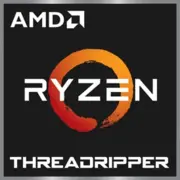AMD Ryzen Threadripper 2950X

AMD Ryzen Threadripper 2950X in 2025: Is This Processor Worth Considering Today?
Key Specifications: Architecture and Performance
The AMD Ryzen Threadripper 2950X, released in 2018, still attracts the attention of enthusiasts and professionals. Its codename is Colfax, architecture Zen+, and it is built on a 12 nm process. Despite its age, the 16 cores and 32 threads make it relevant for multithreaded tasks.
Key Features:
- L3 Cache — 32 MB: Reduces latency when working with large datasets.
- TDP 180 Watts: High power consumption, but justified for the HEDT segment (High-End Desktop).
- Unlocked Multiplier: Overclocking capability for enthusiasts.
- 64 PCIe 3.0 lanes: Supports multiple devices (e.g., several GPUs or NVMe drives).
Performance:
In the Geekbench 6 (2025) test, the 2950X scores 1261 points in single-threaded and 8340 in multi-threaded mode. This is lower than modern processors such as the Ryzen 9 7950X (single-threaded ~2200), yet it still performs well for rendering or virtualization. For example, rendering a 4K project in Blender takes about 12 minutes on it — comparable to the Intel Core i9-12900K.
Compatible Motherboards: TR4 Socket and Chipsets
The Threadripper 2950X uses the TR4 socket, which is compatible only with the X399 chipset. By 2025, such motherboards are no longer produced, but they can be found on the secondary market or in leftover stock from stores.
Popular Models:
- ASUS ROG Zenith Extreme: 8 DDR4 slots, Wi-Fi 5, enhanced power delivery.
- MSI X399 Gaming Pro Carbon AC: Budget option with RGB lighting.
- Gigabyte X399 AORUS Xtreme: Supports 10G Ethernet.
Selection Considerations:
- VRM Modules: Due to the high TDP of the processor, the motherboard should have a robust VRM heat sink.
- PCIe Slots: For multitasking (e.g., 4 GPUs or an NVMe RAID array), look for boards with 3–4 PCIe x16 slots.
Supported Memory: DDR4 and Quad Channel
The Threadripper 2950X works only with DDR4 (DDR5 is not supported). It is recommended to use four memory modules to enable Quad Channel—this increases bandwidth to 85 GB/s.
Recommendations:
- Frequency: Optimal is 2933–3200 MHz. For instance, G.Skill Trident Z RGB 32 GB kits (4x8 GB).
- Capacity: For work tasks, from 64 GB (4x16 GB).
Power Supply: Calculations and Recommendations
With a TDP of 180 Watts and power demands, the minimum power supply wattage is 750 Watts. If a high-end graphics card like the NVIDIA RTX 4080 is installed, it’s better to opt for a supply of 850–1000 Watts.
Model Examples:
- Corsair RM850x (2025): 80+ Gold, modular cables.
- Seasonic PRIME TX-1000: 80+ Titanium, 12-year warranty.
Tip: Don’t skimp on the power supply — unstable power can cause CPU throttling.
Pros and Cons of the Threadripper 2950X in 2025
Pros:
1. Price: In April 2025, a new processor can be found for $500–600 (leftovers from warehouses). In comparison, the Ryzen 9 7950X starts at $800.
2. Multithreading: 32 threads are useful for rendering, code compilation, and virtualization.
3. Scalability: 64 PCIe 3.0 lanes allow for multiple GPU and NVMe connectability.
Cons:
1. Outdated Process Technology: 12 nm compared to 5–4 nm used in modern CPUs.
2. No PCIe 5.0/4.0: NVMe Gen4/Gen5 speeds will be limited.
3. High Power Consumption: 180 Watts versus 120–170 Watts in newer counterparts.
Use Cases: Who Is It Suitable For?
- Workstations: 3D rendering, video editing, CAD.
- Servers: Virtualization (VMware, Proxmox).
- Enthusiasts: Overclocking and hardware experimentation.
However, it’s not ideal for gaming: In 2025 games (e.g., GTA VI or Starfield 2), single-threaded performance will become a bottleneck.
Comparison with Competitors
1. Intel Core i9-10980XE (18 cores): Cheaper (~$400), but poorer in multithreading (Geekbench 6 Multi ~7600).
2. AMD Ryzen 9 5950X (16 cores): Better single-thread performance (~1500 in Geekbench 6), but fewer PCIe lanes.
3. Intel Core i7-14700K (20 cores): Newer, faster in games, but more expensive (~$650).
Practical Assembly Tips
1. Cooling: Due to the 180 Watts TDP, a powerful cooler is necessary. Examples:
- Noctua NH-U14S TR4: Air cooling, TR4 compatible.
- NZXT Kraken X73: 360 mm AIO for overclocking.
2. Case: Choose models with good ventilation (Lian Li PC-O11 Dynamic).
3. Add-ons: A PCIe adapter for NVMe (e.g., ASUS Hyper M.2 X16) will increase the number of drives.
Final Conclusion: Who Should Consider This?
The Threadripper 2950X in 2025 is a choice for:
- Budget Workstations: If you need many cores for $500–600.
- Enthusiasts: Fans of upgrading older systems.
- Professionals: For tasks where parallel processing is important, rather than IPC performance.
Alternative: If the budget allows, it’s better to go for the Ryzen 9 7900X or Intel Core i7-14700K — they are more energy-efficient and faster in modern applications.
Conclusion: Despite its age, the Threadripper 2950X remains a workhorse for specific tasks. However, for gaming or working with AI/neural networks, it is advisable to choose something newer.
Basic
CPU Specifications
Memory Specifications
GPU Specifications
Miscellaneous
Benchmarks
Compared to Other CPU
Share in social media
Or Link To Us
<a href="https://cputronic.com/cpu/amd-ryzen-threadripper-2950x" target="_blank">AMD Ryzen Threadripper 2950X</a>